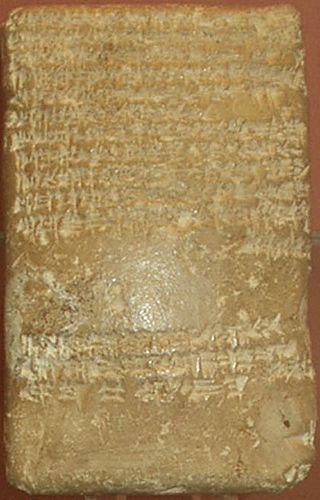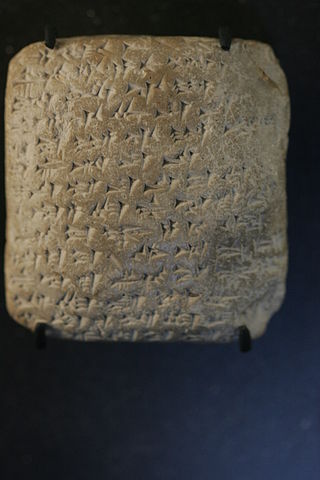
The Amarna letters are an archive, written on clay tablets, primarily consisting of diplomatic correspondence between the Egyptian administration and its representatives in Canaan and Amurru, or neighboring kingdom leaders, during the New Kingdom, spanning a period of no more than thirty years between c. 1360–1332 BC. The letters were found in Upper Egypt at el-Amarna, the modern name for the ancient Egyptian capital of Akhetaten, founded by pharaoh Akhenaten (1350s–1330s BC) during the Eighteenth Dynasty of Egypt.

The land of Subartu or Subar is mentioned in Bronze Age literature. The name also appears as Subari in the Amarna letters, and, in the form Šbr, in Ugarit.
Tob was the name of a place in ancient Israel, mentioned in the Bible.

Labaya was the ruler of Shechem and warlord in the central hill country of southern Canaan during the Amarna Period. He lived contemporaneously with Pharaoh Akhenaten. Labaya is mentioned in several of the Amarna Letters. He is the author of letters EA 252–54.

Rib-Hadda was king of Byblos during the mid fourteenth century BCE. He is the author of some sixty of the Amarna letters all to Akhenaten. His name is Akkadian in form and may invoke the Northwest Semitic god Hadad, though his letters invoke only Ba'alat Gubla, the "Lady of Byblos".
Ushu was an ancient mainland city that supplied the city of Tyre with water, supplies and burial grounds. Its name was based upon the mythical figure Usoos or Ousoüs, a descendant of Genos and Genea whose children allegedly discovered fire, as recorded by Sanchuniathon (Sankunyaton).
Zimredda, also Zimr-Edda or Zimr-Eddi was the mayor of Sidon, in the mid 14th century BC. He is mentioned in several of the Amarna letters, in the late Rib-Hadda series, and later. He authored letters EA 144–45.

Naziba, was a small 'city', or 'city-state' south of Dimašqu-(Damascus), in the 1350–1335 BC Amarna letters correspondence. The town of Naziba was located near Amarna letters Qanu, now named Qanawat, and biblical Kenath.
Addaya was an Egyptian commissioner during the period of the Amarna letters correspondence. The majority of the Amarna letters were written to the pharaoh of Egypt during a 15-20 year(?) time period.

Karduniaš, also transcribed Kurduniash, Karduniash, Karaduniše,) is a Kassite term used for the kingdom centered on Babylonia and founded by the Kassite dynasty. It is used in the 1350-1335 BC Amarna letters correspondence, and is also used frequently in Middle Assyrian and Neo-Assyrian texts to refer to the kingdom of Babylon. The name Karaduniyaš is mainly used in the letters written between Kadashman-Enlil I or Burna-Buriash, Kings of Babylon, and the Pharaoh of Ancient Egypt -, letters EA 1-EA 11, a subcorpus of letters,.

The Salhi is a region/city-state in the vicinity of Ugarit during the 15-20 year Amarna letters correspondence of 1350–1335 BC.

Amarna letter EA 252, titled: Sparing One's Enemies, is a square, mostly flat clay tablet letter written on both sides, and the bottom edge. Each text line was written with a horizontal line scribed below the text line, as well as a vertical left margin-line, scribe line on the obverse of the tablet. The letter contains 14 (15) lines on the obverse, continuing on the bottom tablet edge to conclude at line 31 on the reverse, leaving a small space before the final tablet edge. At least 4 lines from the obverse intrude into the text of the reverse, actually dividing the reverse into a top half and bottom half, and even creating a natural spacing segue to the reverse's text, and the story.

Amarna letter EA 365, titled Furnishing Corvée Workers, is a squarish, mostly flat clay tablet, but thick enough (pillow-shaped), to contain text that continues toward the right margin, the right side of the obverse side, and also to the right side of the reverse side of the tablet.

Amarna letter EA 364, titled Justified War, is a clay tablet letter from Ayyab, ruler of Aštartu, to Pharaoh Akhenaten.

Amarna letter EA 367, titled From the Pharaoh to a Vassal, is a medium-small, square clay tablet Amarna letter to Endaruta of Achshaph,, one of only about 10 letters of the el-Amarna corpus, that is from the Pharaoh of Egypt to his correspondent.

Amarna letter EA 144, titled: "Zimreddi of Sidon," is a square-shaped, mostly flat clay tablet letter written on both sides and the bottom edge. It is from a vassal state in Canaan, and is written by the 'mayor' of Sidon, the author of Amarna letter EA 144, and Amarna letter EA 145. Zimreddi is also referred to in a few other Amarna letters.

Amarna letter EA 362, titled: "A Commissioner Murdered," is a finely-inscribed clay tablet letter from Rib-Haddi, the mayor/'man' of the city of Byblos,. Byblos, being a large coastal seaport Mediterranean city, was a city that was aligned with Egypt (Miṣri), and housed an Egyptian community. Rib-Haddi, as the city-state leader wrote the largest number of letters to the Pharaoh, in a sub-corpus of the 1350 BC Amarna letters.

Amarna letter EA 205, titled: "Ready for Marching Orders (5)" is a short letter from the Ruler of city Ṭubu. The title references that six mostly identical, very short, letters were scribed by the same scribe, from small regional towns; the scribe also is the writer of Amarna letter EA 195. It is not known if each letter was written at the location of each town, or from an alternative site, or sites.

Amarna letter EA 39, titled: "Duty-Free", is a fairly short letter from the King of Alashiya. Almost half the letter, Para I, is a shortened greeting formula. The letter is requesting the Pharaoh to let messengers pass freely, as they are also being represented as merchants; this also applies to their shipping.

Amarna letter EA 290, titled: "Three Against One", is one of the two shorter letters, of six, from Abdi-Heba the governing man of Jerusalem. In the Jerusalem letters, Jerusalem is "Uru-Salem" ("City-Peace").















